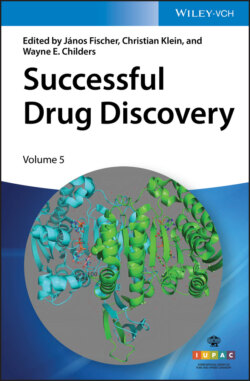Читать книгу Successful Drug Discovery, Volume 5 - Группа авторов - Страница 2
Table of Contents
Оглавление1 Cover
2 Title Page
3 Copyright
4 Advisory Board Members
5 Preface
6 Part I: General Aspects 1 Drug Discovery in Academia 1.1 Introduction 1.2 Repurposing Drugs 1.3 Pregabalin 1.4 Natural Product‐Derived Drug Discovery 1.5 Biologic Drugs 1.6 Conceptionally New Small Molecule Drugs 1.7 Sweet Spot for Academic Drug Discovery List of Abbreviations References Biography 2 From Degraders to Molecular Glues: New Ways of Breaking Down Disease‐Associated Proteins 2.1 Introduction 2.2 Definition and Historical Development of Degraders 2.3 The Ubiquitin–Proteasome System and Considerations of E3 Ligases 2.4 General Design Aspects 2.5 Differentiation of the Degrader Technology to Traditional Approaches 2.6 Potential Disadvantages and Limitations of Degraders 2.7 Molecular Glue‐like Degraders and Monovalent Degraders 2.8 Future Directions (Status Q3 2020) 2.9 Summary and Conclusions Acknowledgments List of Abbreviations References Biographies
7 Part II: Drug Class Studies 3 GLP‐1 Receptor Agonists for the Treatment of Type 2 Diabetes and Obesity 3.1 Introduction 3.2 GLP‐1 Biology 3.3 Ex4‐Based Analogues 3.4 GLP‐1 Based Analogues 3.5 Co‐agonists 3.6 Summary List of Abbreviations References Biographies 4 Recent Advances on SGLT2 Inhibitors: Synthetic Approaches, Therapeutic Benefits, and Adverse Events 4.1 Introduction 4.2 The Mechanism of Action of SGLT2 Inhibitors 4.3 Synthetic Approaches to Gliflozins 4.4 Clinical Benefits of SGLT2 Inhibitors 4.5 Safety Profile and Particularly Relevant Adverse Events Associated with SGLT2 Inhibitors 4.6 Application of SGLT2 Inhibitors in Type 1 Diabetes 4.7 Conclusions Acknowledgments References Biographies 5 CAR T Cells: A Novel Biological Drug Class 5.1 Introduction 5.2 A Brief History of Cell‐Based Therapies 5.3 Genetically Engineered T Cell Therapy Products 5.4 CAR T Cells: The Living Drug 5.5 Translation from Laboratory Innovation to Approved Therapy 5.6 Future Directions and CAR T Programs to Consider 5.7 Additional Resources for Supplementary Information on Cellular Therapies, Including Regulations, Notifications, and Guidelines References Biographies 6 CGRP Inhibitors for the Treatment of Migraine 6.1 Introduction 6.2 The Overall Physiological Role of CGRP 6.3 The Role of CGRP in the Gut 6.4 What Is the Role of CGRP in Migraine? 6.5 Role of CGRP Antagonists in Other Indications 6.6 Conclusions List of Abbreviations References Biographies
8 Part III: Case Studies 7 Discovery and Development of Emicizumab (HEMLIBRA® ): A Humanized Bispecific Antibody to Coagulation Factors IXa and X with a Factor VIII Cofactor Activity 7.1 Introduction 7.2 Preclinical Experience with Emicizumab 7.3 Clinical Experience with Emicizumab 7.4 Conclusions Acknowledgments Conflict of Interests References Biographies 8 Discovery and Development of Ivosidenib (AG‐120: TIBSOVO® ) 8.1 Introduction 8.2 Crystal Structure of IDH1 8.3 Search for mIDH1 Inhibitors 8.4 Hit to Lead Exploration 8.5 Lead Optimization: Discovery of AG‐120 8.6 Synthesis of AG‐120 8.7 Preclinical Characterization of AG‐120 8.8 Ivosidenib Clinical Studies 8.9 Conclusions References Biographies 9 The Discovery of Kisqali® (Ribociclib): A CDK4/6 Inhibitor for the Treatment of HR+/HER2− Advanced Breast Cancer 9.1 Disease Background 9.2 Target Background and Validation: The Cell Cycle 9.3 Commencement of Drug Discovery Efforts 9.4 Fragment‐based Approach 9.5 Cross‐Screening of Existing Kinase Assets Leading to Ribociclib 9.6 Combination Treatments with Ribociclib 9.7 Early‐Phase Clinical Studies 9.8 Phase 3 Clinical Studies 9.9 Conclusions Acknowledgments References Biographies
9 Index
10 End User License Agreement
